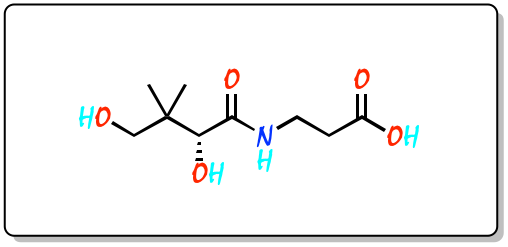What is pantothenic acid?
Pantothenic acid or vitamin B5, or vitamin W, is a water-soluble vitamin of the B vitamins group, necessary for life. It was discovered by Roger J. Williams in 1931 as a cofactor for yeast growth.
The systematic name of the IUPAC for vitamin B5 is 3-[(2R)-2,4-dihydroxy-3,3-dimethylbutanamido]propanoic acid.
Chemical structure
Structurally, pantothenic acid is the amide formed between pantoic acid (an α-hydroxy acid) and the amino acid β-alanine.
 |
| 3D Structure |
Functions
Pantothenic acid has several critical functions in the body, including helping to convert proteins, carbohydrates and fats into energy and aiding in the production of hormones and antibodies. The human body needs it in order to produce coenzyme-A (CoA). It is referred to as an “anti-stress” vitamin because of its ability to relieve depression and anxiety. Pantothenic acid works synergistically with vitamins B1, B2 and B3 to produce energy for the body in the form of ATP.
Chemical synthesis
It was first synthesized in 1940, in 1940, by Stiller et al. by the amide-forming reaction between (+)-α,γ-dihydroxy-β,β-dimethylbutyric acid with β-aminopropionic acid.
Food sources
Pantothenic acid can be found in almost all foods (pantothenic derives from a Greek word meaning “from everywhere”).
The best sources include brewer’s yeast, wheat germ, wheat bran, peanuts, peas, whole grains, broccoli, mushrooms and sweet potatoes.